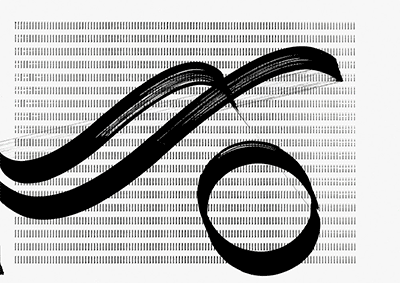The Signes Association, dedicated to history and current events in graphic arts and typography was founded by Michel Wlassikoff, an historian of graphic design. In addition to the dissemination of key texts in the history of typography, Signes organizes workshops themed around a variety of digital tools. We set out to learn more about this initiative.
Back Office What are some of the challenges in organizing the Signes Association workshops?
Signes In September 2015 we organized our first workshop, entitled Vectors. Designed for students and young professionals, graphic designers and artists, it was the first of a series of workshops devoted to the tools of graphic and visual design. 11 Workshop #01—Vectors was held from September 7 to 11, 2015, at the École de Condé, Paris. The exhibition took place the day after at the Espace Player in Paris. Beginning with the idea that digital devices have elicited a visual liberation, facilitated a number of technical processes, but also closed a lot of doors, we feel that it is now time to question these notions. In fact, the computer-based production line dominates, and no matter how productive it may be, it holds certain technical solutions in a veritable monopoly, thereby doing away with any questioning regarding ways of doing things. A transversal software solution (Adobe), designed for everyone involved in the graphic production process, comes across as an “industry standard” that is hard to get around. Working each session with a new creative tool disrupts the participants’ usual workflows, making them more aware of the downside of the software packages at their disposal, and encouraging them to program their own devices.
B O What device have you chosen for the first workshop?
S We’ve decided to offer participants the use of a Roland XY-Plotter DXY-1330, which was first marketed in the 1980s. This compact plotter, capable of interfacing with the first technical drawing software, was a real innovation in its day, and is fitted with a pen holder with eight positions. You can use several drawing tools with it and change them during printing. We were keen to develop this specific technical feature by offering participants a selection of suitable tools and materials that can be personalized, then fixed to the machine’s pen holder: felt-tips, ball-point, reed pens, foam brushes, oil pastels, sponges, and even an airbrush were designed for the machine during the workshop.
B O Why work with a 1980s’ plotter rather than a classic printer?
S Compared with contemporary printers, this plotter has the major restriction of only being controllable by vector design instructions. To start working, the plotter actually interprets the HP-GL language which contains a lot of design instructions and abstractions similar to other graphic languages like SVG. In addition to controls associated with the motif to be described, HP-GL also includes instructions specific to the working of this type of machine like: “take pen,” “lower pen,” “go to position (axes X and Y),” “raise pen.” It is similar to the G-Code language used by the digitally controlled machines of the fablabs.
Each machine was delivered with a technical manual detailing the instructions managed by the plotter, together with a number of computer code examples that can meet the user’s specific requirements. So HP-GL is a de facto “open technology.” Contemporary programs are well removed from this paradigm: user systems use colorimetric spaces (ICC) and image-compressing algorithms (JPEG, GIF, etc.), mostly proprietary, and the closed file formats of the graphic industry standards (PSD, AI, INDD, etc.) prevent the work being portable, and printing guides are among the most opaque software there is. The user experiences printing as a passive process.
B O How did these constraints benefit the workshop?
S The difficulty for the participants lay in writing a correctly formatted HP-GL file, and getting one written that could be transmitted to the machine. We didn’t dictate any method, but rather we provided a variety of protocols that offered a certain flexibility. Some participants interacted directly with the HP-GL in a plain-text editor. But most of them chose to work through visual software packages (Illustrator, Inkscape) and convert their files (SVG or EPS) to the HP-GL format. It’s relatively easy to vary the physical tools managed by the Roland DXY-1300, but it’s especially difficult to comply with the rigor imposed by the syntax of the HP-GL code. During the workshop, it was very common to see the printing being done in fragments, an apparently recurrent feature when using Illustrator. When the machine couldn’t manage to execute the data, it plotted each vector without regard to the actual image, thus revealing the abstractions and short cuts used by Adobe in the formatting of its proprietary files. Consequently, one sees that composing a page and exporting it in file form are still two distinct processes, something the graphic interfaces of recent software packages have a tendency to overlook.
When the machine couldn’t manage to execute the data, it plotted each vector without regard to the actual image, thus revealing the abstractions and short cuts used by Adobe in the formatting of its proprietary files. Consequently, one sees that composing a page and exporting it in file form are still two distinct processes, something the graphic interfaces of recent software packages have a tendency to overlook.
We’re hoping that this workshop has shed light on the fact that graphic designers play an active part within the graphic production line, and can choose to adopt a critical stance towards standards imposed by industry, even if this means reimagining production methods and creating their own tools, no matter how rudimentary they may be.